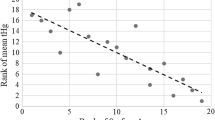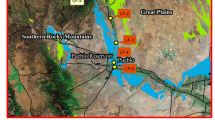Abstract
The trace metal content and related safety (health risk) of Hackensack River fish were assessed within the Hackensack Meadowlands of New Jersey, USA. Eight elements were analyzed in the edible portion (i.e., muscle) of species commonly taken by anglers in the area. The white perch collection (Morone americana) was large enough (n = 168) to enable statistically significant inferences, but there were too few brown bullheads and carp to reach definite conclusions. Of the eight elements analyzed, the one that accumulates to the point of being a health risk in white perch is mercury (Hg). Relationships between mercury concentrations and size and with collection season were observed; correlation with lipid content, total polychlorinated biphenyl (PCB) content, or collection site were very weak. Only 18% of the Hg was methylated in October (n = 8), whereas June and July fish (n = 12) had 100% methylation of Hg. White perch should not be considered edible because the Hg level exceeded the “one meal per month” action level of 0.47 μg/g wet weight (ppm) in 32% of our catch and 2.5% exceeded the “no consumption at all” level of 1 μg/g. The larger fish represent greater risk for Hg. Furthermore, the warmer months, when more recreational fishing takes place, might present greater risk. A more significant reason for avoiding white perch is the PCB contamination because 40% of these fish exceeded the US Food and Drug Administration (FDA) action level of 2000 ng/g for PCBs and all white perch exceeded the US Environmental Protection Agency cancer/health guideline (49 ng/g) of no more than one meal/month. In fact, nearly all were 10 times that advisory level. There were differences between male and female white perch PCB levels, with nearly all of those above the US FDA action level being male. Forage fish (mummichogs and Atlantic silversides) were similarly analyzed, but no correlations were found with any other parameters. The relationship of collection site to contaminants cannot be demonstrated because sufficient numbers of game fish could not be collected at many sites at all seasons.








Similar content being viewed by others
References
Ashley JTF, Baker JE, Zlokovitz E, Secor D, Wales S (2000) Linking habitat use of Hudson River striped bass to accumulation of PCB congeners. Environ Sci Technol 34:1023–1029
Ashley JTF, Horwitz R, Ruppel B, Steinbacher J (2003) A comparison of accumulated PCB patterns in American eels and striped bass from the Hudson and Delaware River estuaries. Mar Pollut Bull 46:1294–1308
Bloom NS (1992) On the chemical form of mercury in edible fish and marine invertebrate tissue. Can J Fish Aquat Sci 49:1010–1017
Bunton TE, Baksi SM, George SG, Frazier JM (1987) Abnormal hepatic copper storage in a teleost fish (Morone americana). Vet Pathol 24:515–524
European Communities (2001) Commission regulation (EC) No. 466/2001 of 8 March 2001 setting maximum levels for certain contaminants in foodstuffs. Off J Eur Communities L77, 10
Faust BC (1992) The octanol/water distribution coefficients of methylmercuric species: the role of aqueous-phase chemical speciation. Environ Toxicol Chem 11:1373–1376
Hall BD, Bodaly RA, Fudge RJP, Rudd JWM, Rosenberg DM (1997) Food as the dominant pathway of methylmercury uptake by fish. Water Air Soil Pollut 100:13–24
Hauge P, Bukowski J, Morton P, Boriek M, McClain J, Casey G (1990) Polychlorinated biphenyls (PCBs), chlordane, and DDTs in selected fish and shellfish from New Jersey waters, 1986–1987: Results from New Jersey’s Toxics in Biota Monitoring Program. NJ Dept of Environ Protection, Trenton. Available from http://www.state.nj.us/dep/dsr/pcb86-87.pdf
Hebert CE, Keenleyside KA (1995) To normalize or not to normalize? Fat is the question. Environ Toxicol Chem 14:801–807
Irgolic KJ (1992) Arsenic. In: Hazardous metals in the environment. Stoeppler M (ed) Elsevier Science, Amsterdam
Kannan K, Smith RG, Lee RF, et al. (1998) Distribution of total mercury and methyl mercury in water, sediment, and fish from South Florida estuaries. Arch Environ Contam Toxicol 34:109–118
King RS, Beaman JR, Whigham DF, Hines AH, Baker ME, Weller DE (2004) Watershed land use is strongly linked to PCBs in white perch in Chesapeake Bay subestuaries. Environ Sci Technol 38:6546–6552
Linkov I, Ames MR, Crouch EA, Satterstrom FK (2005) Uncertainty in octanol–water partition coefficient: implications for risk assessment and remedial costs. Environ Sci Technol 39:6917–6922
Mason RP (2004) Methylmercury concentrations in fish from tidal waters of the Chesapeake Bay. Maryland Department of Natural Resources Report CDWP-MANTA-AD-04-1
Mason RP, Fitzgerald WF, Hurley JP, Hanson AK Jr, Donaghay PL, Sieburth JM (1993) Mercury biogeochemical cycling in a stratified estuary. Limnol Oceanogr 38:1227–1241
McGrath PE (2005). Site fidelity, home range, and daily movements of white perch, Morone americana, and striped bass, Morone saxatilis, in two small tributaries of the York River, Virginia. MS thesis. Virginia Institute of Marine Science
Rasmussen JB, Rowan DJ, Lean DRS, Carey JH (1990) Food chain structure in Ontario lakes determines PCB levels in lake trout (Salvelinus namaycush) and other pelagic fish. Can J Fish Aquat Sci 47:2030–2038
Rhinefelder JR, Fisher NS, Luoma SN, Nichols JW, Wang W-X (1998) Trace element trophic transfer in aquatic organisms: a critique of the kinetic model approach. Sci Total Environ 219:117–135
Stow CA, Jackson LJ, Amrhein JF (1997) An examination of the PCB:lipid relationship among individual fish. Can J Fish Aquat Sci 54:1031–1038
Suedel BC, Boraczek JA, Peddicord RK, Clifford PA, Dillon TM (1994) Trophic transfer and biomagnification potential of contaminants in aquatic ecosystems. Rev Environ Contam Toxicol 136:21–89
Swackhamer DL (1987) Quality assurance plan for Green Bay mass balance study: PCBs and dieldrin. US Environmental Protection Agency, Great Lakes National Program Office; Chicago, Illinois
US EPA (1999a) Guidance for assessing chemical contaminant data for use in fish advisories. Vol. 2. Risk assessment and fish consumption limits, 3rd ed. EPA 823-B-99-008. US EPA, Office of Water, Washington, DC
US EPA (1999b) Polychlorinated biphenyls (PCBs) update: Impact on fish advisories. EPA-823-F-99-019. US EPA, Office of Water, Washington, DC
US EPA (1999c) Mercury update: impact on fish advisories. EPA-823-F-99-019. US EPA, Office of Water, Washington, DC
US EPA (2000) Guidance for assessing chemical contamination data for use in fish advisories. Vol. 2. Risk assessment and fish consumption limits, 3rd ed. EPA 823-B-00-008. Office of Water, Washington, DC
US EPA (2001) Mercury update: Impact on fish advisories. EPA-823-F-01-011. US EPA, Office of Water, Washington, DC
US FDA (1993) National Shellfish Sanitation Program. Guide for the control of molluscan shellfish . US Food and Drug Administration, Washington, DC
Weis JS (2005) Diet and food web support of the white perch, Morone americana, in the Hackensack Meadowlands of New Jersey. Environ Biol Fish 74:109–113
Weis P, Weis JS, Bogden JD (1986) Effects of environmental factors on release of mercury from Berry’s Creek (New Jersey) sediments and its uptake by killifish Fundulus heteroclitus. Environ Pollut A 40:303–315
Acknowledgments
The assistance of many people is gratefully acknowledged: at the NJMC, Brett Bragin, who led the collection team, Yefim Lewinsky, who performed much of the atomic absorption spectrophotometry, and Edward Konsevick, who performed data management; at UMDNJ, Theodore Proctor, who has been an invaluable lab assistant for many years, for tissue processing and atomic absorption spectrophotometry; at the Academy of Natural Sciences, Ms. Linda Zaoudeh for organic contaminant analyses. This project was part of a multifaceted, multi-institutional study funded by the Meadowlands Environmental Research Institute.
Author information
Authors and Affiliations
Corresponding author
Rights and permissions
About this article
Cite this article
Weis, P., Ashley, J.T. Contaminants in Fish of the Hackensack Meadowlands, New Jersey: Size, Sex, and Seasonal Relationships as Related to Health Risks. Arch Environ Contam Toxicol 52, 80–89 (2007). https://doi.org/10.1007/s00244-006-0093-4
Received:
Accepted:
Published:
Issue Date:
DOI: https://doi.org/10.1007/s00244-006-0093-4




